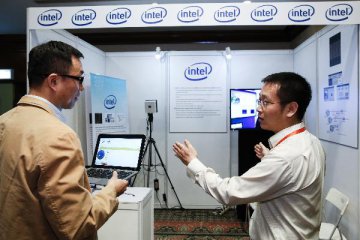
That has been pretty hard to overlook lately. The next-generation wireless standard has become both the “Next Big Thing” in tech as well a political football that figures prominently in the growing trade dispute between the U.S. and China.
Consumers will soon be inundated with marketing for 5G devices and services expected to be introduced at the giant Consumer Electronics Show and Mobile World Congress, two technology conferences taking place over the next couple of months. Samsung, Huawei, Xiaomi and Oppo—four of the five largest smartphone makers in the world—are all expected to launch 5G phones this year.
Investors are also being inundated already. The four largest U.S. wireless carriers alone—Verizon, AT&T , Sprint and T-Mobile—mentioned 5G an average of 28 times each in their most recent earnings calls. Qualcomm , the wireless chip-maker that has made 5G central to its plans for recovery from a disastrous run of luck over the last couple of years, mentioned the term 38 times in its most recent call.
That hype masks a more complicated reality. 5G will most certainly be big—eventually. Wireless networks are always evolving. And the benefits promised by 5G, which include superfast speeds for users and much greater efficiency for network operators, are compelling. Many of the early 5G networks will offer faster download speeds than some of the fastest cable-modem networks today.
But these kinds of rollouts take time—and money. Final technical standards for the most robust levels of 5G that could offer download speeds of 20 gigabits per second aren’t even expected to be completed until next year. Wireless carriers also have to balance investments in new technology against network maintenance and many other demands.
So while both AT&T and Verizon are currently rolling out services branded as 5G, Wall Street expects both carriers to keep capital spending relatively flat in 2019, suggesting that wide-scale availability of true 5G networks is further out.
Slowing the speed of the rollout is weak growth in the wireless business compared with previous transitions. Smartphone unit sales were rising more than 60% a year during the start of the last transition, to LTE in 2011. By contrast, the most optimistic forecast now calls for smartphone sales to rise less than 3% in the coming year after having fallen over the last two. IDC estimates smartphone sales will average 1.4% growth over the next five years.
The problem with launching 5G phones in such a market is that they deliver an unclear value proposition—especially with limited availability of 5G networks. Most analysts don’t expect Apple to launch a 5G version of the iPhone until 2020. JPMorgan estimates that 5G phones will account for less than 1% of total global unit sales in 2019. And services such as augmented reality that would benefit greatly from 5G speeds still aren’t big draws for consumers.
As Cliff Maldonado of BayStreet Research put it, “ Facebook and email won’t be any different on 5G.”





















Latest comments